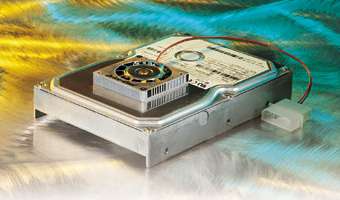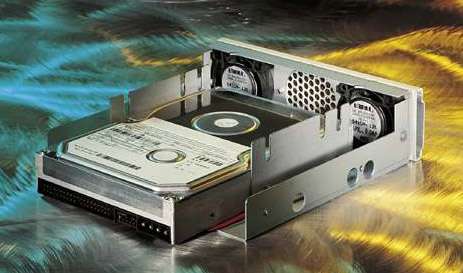[ The PC Guide | Systems and Components Reference Guide | Hard Disk Drives | Construction and Operation of the Hard Disk | Hard Disk Packaging and Mounting ]
Temperature Limits and Drive Cooling
Hard disks can only be counted upon to perform reliably if they are kept within their specified temperature ranges. Cooling has become one of the most important considerations for reliability, particularly for newer drives running at high spindle speeds. See this discussion of cooling in the section on hard disk quality for more.
For the first 15 years of the PC's existence, hard drives were always passively cooled: the metal case of the drive itself was used to sink most of the heat generated inside it. Some of the heat was conducted to the metal insides of the system case, and the air flow within the case took care of the rest. Overheating problems were rare. Cases were generally large and better-ventilated than the average PC is today, and in fact before the mid-to-late 1990s, few people other than those designing large servers gave much thought at all to cooling disk drives. You put it in the case, made sure the power supply fan was working properly, and that was pretty much all there was to it.
This situation changed with the introduction of the first 7,200 RPM drives. These drives, with their faster more powerful spindle motors, generated more heat than had been seen before in hard disks. In fact, heat issues are common with each first-generation drive family using a newer, faster spindle speed (hard drive engineers generally do a good job of working on the heat issues with subsequent revisions of each design). The end result is that for some 7,200 RPM and 10,000 RPM drives, just sticking the drive in the case and hoping for the best is not sufficient.
When trying to keep a hot drive within operating parameters, the most important first step is to address the cooling of the case overall. It's essential that the fan(s) are functioning properly and have sufficient capacity for the case. The PC must not be operated in a very hot room or placed where it will be excessively heated (for example, in direct sunlight or right next to a heater). The case should not be too small for the number of devices it contains. Hard drives should also be spaced to allow proper air flow over them--putting two drives very close together is not a good idea. See this discussion of system cooling for more on this subject.
If the system's cooling isn't sufficient for a hot-running hard disk, you have some options. Various manufacturers make devices specifically for cooling hard disks. They usually come in two basic forms:
- Drive Coolers: These are essentially fan and heat sink combos, similar to those used for CPUs, but designed specially to be used with hard disks. They are attached to the drive using thermal conductive tape, and blow air directly onto the drive case to cool it.
|
A drive cooler mounted on top of a standard 3.5" |
Original image � PC Power & Cooling, Inc. |
- Bay Coolers: These devices are similar in design to the drive bay adapters available for mounting a 3.5" form factor drive into a 5.25" drive bay, except that they add cooling for the drive. The disk is mounted into the cooler, which contains one or more integrated fans. The cooler then is mounted into one of the larger 5.25" drive bays found in most PCs.
|
A 5.25" bay cooler with a 3.5" form factor
hard disk installed in it. |
Original image � PC Power & Cooling, Inc. |
In both designs power is provided for the fan(s) through the use of a standard drive connector.
![]() Tip: Simply mounting a 3.5" form factor hard disk into a
5.25" drive bay with a metal adapter kit will help to cool the drive in some
cases by providing two additional metal pieces adjacent to the drive to act as small heat
sinks.
Tip: Simply mounting a 3.5" form factor hard disk into a
5.25" drive bay with a metal adapter kit will help to cool the drive in some
cases by providing two additional metal pieces adjacent to the drive to act as small heat
sinks.
Do you need active cooling for your hard disk? There's no easy answer to that question: it depends on a number of different factors. Most PC users do not need to add special coolers for their hard disks. This is especially true of consumer IDE/ATA drives--since manufacturers know most people pay little attention to cooling, they must assume no special cooling when selling these drives through retail channels, or they'd end up having to deal with a flood of warranty replacements. For higher-speed SCSI drives, additional cooling may be required. You will have to determine the need by assessing the cooling level of your system, the temperature requirements and heat generation level of the particular drive, how many drives are going to be put into the system, and similar factors. If you are buying a pre-made system, the system manufacturer should be dealing with these design issues for you.
![]() Next: Retail and OEM Packaging
Next: Retail and OEM Packaging
| The PC Guide
(http://www.PCGuide.com) Site Version: 2.2.0 - Version Date: April 17, 2001 © Copyright 1997-2004 Charles M. Kozierok. All Rights Reserved. |
Not responsible for any loss resulting from the use of this site. Please read the Site Guide before using this material. |

